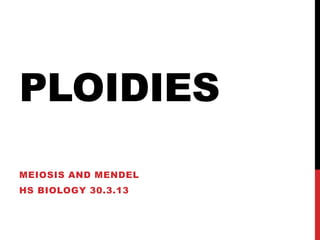
Nondisjunction and Polyploidy
- 1. PLOIDIES MEIOSIS AND MENDEL HS BIOLOGY 30.3.13
- 2. PLOIDY AND YOU DIPLOID CELLS (2N) HAPLOID CELLS (N) Mitosis produces Meiosis produces diploid cells, which haploid cells, which in humans have 46 in humans have 23 chromosomes. chromosomes.
- 3. The normal process of meiosis turns diploid body cells (2n) into haploid sex cells (n), in two steps. First, homologous chromosome pairs separate in meiosis 1. Then, sister chromatids separate in meiosis 2.
- 4. SOMETIMES, CHROMOSOMES GET STUCK DURING MEIOSIS. THIS IS CALLED CHROMOSOMAL NONDISJUNCTION
- 5. Nondisjunction leaves us with messed up gametes. Instead of having 23 chromosomes, they may have 22, 24, or even another number. Your body will often purge these germ cells before they ever get a chance to fertilize. But if they do…
- 6. (A FEW TOO MANY OR TOO FEW CHROMOSOMES) ANEUPLOIDY
- 7. DOWN SYNDROME (TRISOMY 21) Total chromosomes: 47 Either the sperm or egg cell has an extra copy of chromosome 23 due to nondisjunction during meiosis. The child can be a boy or a girl. Symptoms include: short stature, weak muscles, distinct facial features, intellectual disability, heart defects, eye conditions, hearing problems, dental problems, ADHD.
- 8. TURNER SYNDROME (MONOSOMY X) Total chromosomes: 45 Either the sperm was missing an X or Y chromosome, or the egg was missing the X chromosome and the sperm carried the Y chromosome. The baby is always female. Symptoms include: wide neck and small jaw, distinct facial features, small stature, learning disabilities, autism, lack of puberty, early menopause, infertility.
- 9. Sometimes, meiosis goes catastrophically wrong, and the gametes end up with a complete double set of chromosomes (or a complete missing set). This is called complete nondisjunction, and the body usually identifies and purges these gametes. However, if a 2n gamete goes on to fertilize another normal gamete…
- 10. (FULL SETS OF EXTRA CHROMOSOMES) POLYPLOIDY
- 11. TRIPLOID SYNDROME Total chromosomes: 69 Either the sperm or the egg has two full sets of chromosomes, leading to a triploid (3n) baby. In humans, triploid babies will either miscarry or die within the first year of life
- 12. SUCCESSFUL POLYPLOIDY Polyploidy in non-human species is not always fatal. Plants, especially, can survive and even thrive with extra sets of chromosomes. One reason for this is self-fertilization: plants can combine their own gametes, even after nondisjunction. For example, two messed up diploid gametes (2n) can combine to make a tetraploid (4n) plant, which will continue to have diploid gametes in the next generation. That doubles a plant species’ chromosomes in one generation!
- 13. Most plants we eat are either a result of (1) ancient, accidentally polyploidy or (2) intentional polyploidy due to modern agricultural techniques. Here are some relatively dramatic examples: Diploid (2n) & Tetraploid (4n) grapes
- 14. Monoploid (n) and triploid (3n) plant lines are usually sterile, and sometimes seedless.
